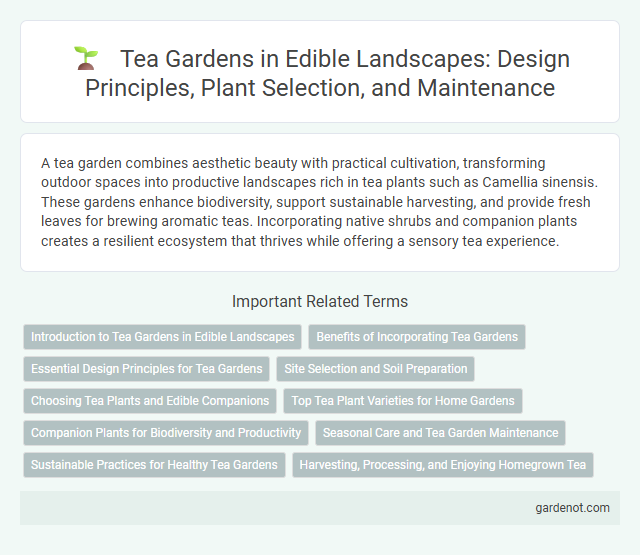A tea garden combines aesthetic beauty with practical cultivation, transforming outdoor spaces into productive landscapes rich in tea plants such as Camellia sinensis. These gardens enhance biodiversity, support sustainable harvesting, and provide fresh leaves for brewing aromatic teas. Incorporating native shrubs and companion plants creates a resilient ecosystem that thrives while offering a sensory tea experience.
Introduction to Tea Gardens in Edible Landscapes
Tea gardens in edible landscapes integrate Camellia sinensis plants to create sustainable, multi-functional green spaces that yield fresh tea leaves while enhancing biodiversity. These gardens optimize soil health and microclimate conditions, supporting organic growth without synthetic inputs. Incorporating tea plants into edible landscaping promotes cultural heritage, health benefits, and eco-friendly gardening practices.
Benefits of Incorporating Tea Gardens
Incorporating tea gardens into edible landscapes enhances biodiversity by attracting pollinators and beneficial insects, improving overall ecosystem health. Tea plants provide a sustainable source of fresh leaves for homegrown beverage production, reducing reliance on commercial tea products and lowering carbon footprints. Cultivating tea gardens also promotes soil conservation through deep root systems and offers educational opportunities about plant cultivation and traditional harvesting methods.
Essential Design Principles for Tea Gardens
Essential design principles for tea gardens include selecting aromatic tea plants like Camellia sinensis to create a sensory-rich environment, integrating pathways that encourage relaxation and mindfulness, and incorporating natural elements such as water features and shade trees to enhance the overall ambiance. Emphasis on sustainable practices like companion planting and organic soil management ensures healthy plant growth and ecological balance. Thoughtful spatial arrangement fosters harmony between functionality and aesthetics, making the tea garden both visually appealing and highly practical.
Site Selection and Soil Preparation
Selecting a tea garden site requires well-drained, slightly acidic soil with a pH between 4.5 and 6.5, preferably located in a region with annual rainfall of 1200-1400 mm and elevation ranging from 600 to 2000 meters for optimal growth. Soil preparation involves deep plowing to improve aeration and drainage, supplemented with organic matter such as compost or well-rotted manure to enhance fertility and structure. Proper site selection combined with thorough soil conditioning ensures healthy tea plants and higher yields in edible landscape designs.
Choosing Tea Plants and Edible Companions
Selecting tea plants such as Camellia sinensis requires consideration of climate, soil pH, and sunlight exposure to ensure optimal growth and flavor development. Edible companions like mint, lemon balm, and borage enhance pest control and attract pollinators without competing for nutrients. Integrating these plants creates a balanced ecosystem, promoting healthy tea bushes and sustainable harvests.
Top Tea Plant Varieties for Home Gardens
Top tea plant varieties for home gardens include Camellia sinensis, prized for its rich flavor and adaptability to various climates, and Camellia assamica, known for its robust leaves ideal for strong black tea. Varieties like Darjeeling and Assam provide unique aromatic qualities that enhance the sensory experience of homegrown tea. Growing these tea plants in edible landscapes not only offers a sustainable source of fresh tea leaves but also enriches garden biodiversity.
Companion Plants for Biodiversity and Productivity
Tea gardens thrive when companion plants like chamomile, mint, and comfrey are incorporated to enhance biodiversity and natural pest control. These plants improve soil health through nitrogen fixation and attract pollinators such as bees and butterflies, boosting overall tea yield. Integrating such companion species supports sustainable cultivation by promoting ecological balance and reducing the need for chemical inputs.
Seasonal Care and Tea Garden Maintenance
Seasonal care in a tea garden involves regular pruning, mulching, and soil enrichment to promote healthy new growth and maintain optimal leaf quality. Maintenance tasks include monitoring pest control, irrigating appropriately to prevent drought stress, and removing weeds to reduce competition for nutrients. Proper seasonal attention ensures sustained productivity and enhances the flavor profile of harvested tea leaves.
Sustainable Practices for Healthy Tea Gardens
Sustainable practices in tea gardens prioritize organic cultivation, minimizing chemical pesticides and fertilizers to maintain soil health and biodiversity. Implementing water-efficient irrigation systems and shade management enhances plant growth while conserving resources. Integrating native plants and promoting natural pest predators fosters a balanced ecosystem essential for healthy, resilient tea crops.
Harvesting, Processing, and Enjoying Homegrown Tea
Harvesting tea leaves from a homegrown edible landscape requires careful plucking of the youngest, tender leaves for optimal flavor and health benefits. Processing involves withering, rolling, oxidizing, and drying the leaves to produce various types of tea such as green, black, or oolong, depending on the desired taste profile. Enjoying homegrown tea offers a unique, fresh experience that highlights the natural aromas and flavors cultivated right from your own garden.
Tea garden Infographic

 gardenot.com
gardenot.com